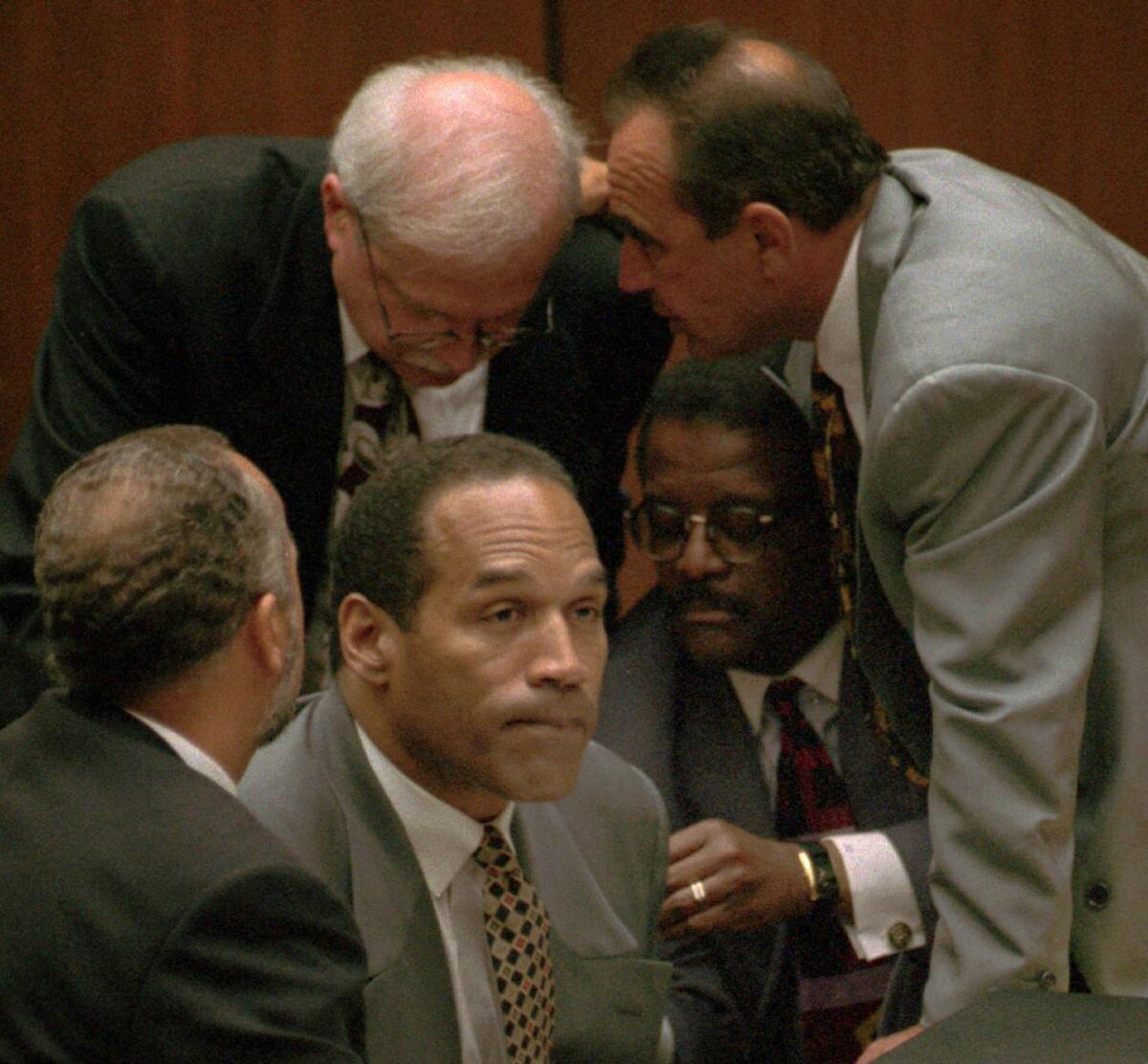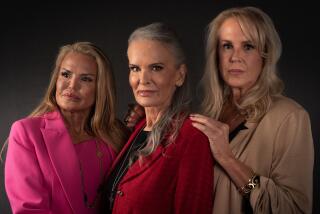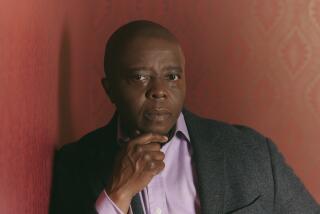Op-Ed: Why ‘The People v. O.J. Simpson’ should be required watching for America’s police chiefs

O.J. Simpson is surrounded by his attorneys — clockwise from left, Ken Spaulding (back toward camera), Gerald Uelmen, Robert Shapiro and Johnnie Cochran Jr. — in court in Los Angeles on Aug. 29, 1995.
- Share via
“The People v. O.J. Simpson: American Crime Story,” FX’s new miniseries about one of L.A.’s most spectacular celebrity trials, isn’t perfect. It gets some details a little wrong — it conflated Nicole Brown Simpson’s funeral with the viewing of her body in the first episode, for instance, and exaggerated to the point of caricature the eccentricities of a couple of significant players. But when it comes to the big thing about the case, “The People v. O.J. Simpson” is exactly right.
By 1994, when Nicole Brown Simpson and Ron Goldman were slain in Brentwood, the Los Angeles Police Department had so ruptured its relationship with those it served that even the most unlikely accusations against it could be taken seriously.
The miniseries opened Tuesday with a sequence that telegraphed that context. The first shot was a clip from the videotaped beating of Rodney G. King on March 3, 1991. It then segued into a series of depictions of the riots that happened the following year, after the officers responsible for King’s beating were acquitted of all but one count in state court (the jury hung on that charge).
Those images were painful to watch — I covered the federal trial of those officers, as well as the riots and Simpson’s murder trial — but the series smartly grasped the intersection of those tortuous and sometimes terrifying events.
For many, the videotape of the King beating was overdue vindication, proof at last that they had been telling the truth when they accused LAPD officers of brutality, especially in their treatment of black male suspects. Indeed, the most shocking aspect of the tape may not even have been the torrent of blows inflicted on King but rather the fact that none of the 19 LAPD officers who witnessed the incident bothered to report anything wrong until after the video surfaced.
By 1994 ... the Los Angeles Police Department had so ruptured its relationship with those it served that even the most unlikely accusations against it could be taken seriously.
When a Ventura County jury in 1992 refused to hold those officers criminally liable for despicable actions the whole world could see, Angelenos’ sense of vindication curdled into fury. Hundreds of structures were burned; dozens of people killed. Even President George H.W. Bush described the officers’ actions as “revolting.”
Compounding the anger directed against the LAPD officers involved in the King beating was despair over the department’s response to the unrest that followed. When the riots began, Chief Daryl F. Gates was attending a fundraiser to defeat police reform. In his absence, the department moved indecisively as crowds gathered and turned violent. At police headquarters that afternoon I watched in amazement as a mob overturned a guard shack and set it on fire. Those on duty at Parker Center stayed inside and watched.
The investigations of the LAPD in those years — by various commissions, the press and others — offered shocking confirmation of a culture that had gone dangerously wrong. Police slang for incidents of domestic violence in African American homes was “NHI.” That stood for “no humans involved.” On the night of the King beating, one of the officers used a department mobile device (this was before cellphones) to describe to a colleague another such incident as “right out of Gorillas in the Mist.” Another officer gave this advice to a colleague confronting a suspect: “Capture him, beat him and treat him like dirt.”
It was against that history that Simpson’s defense team served up its critique of the case against its client: The LAPD, it argued, was so sloppy it might have mishandled important evidence, and the department was so corrupt that it was capable of framing a famous suspect, especially a black man.
There were many reasons to doubt the notion of a frame-up. Chiefly: Simpson was eminently recognizable, so if police planted evidence to frame him, they would have risked later discovering that he had a solid alibi. That would have turned their plot against them.
But what the defense team exploited, and what the FX series conveys, is that it’s almost beside the point to argue for or against the idea that Simpson was framed. By 1994 in L.A., such a thing wasn’t out of the question, and a jury presented with that argument wasn’t crazy to believe it.
There is a profound lesson in the trial and acquittal of O.J. Simpson for the many police departments today wrestling with declining public confidence in their integrity. Just last week, a Chicago Tribune poll found that more than half of all residents of the nation’s third-largest city distrust their police force. It seems safe to assume that’s true in places like Ferguson, Mo.; North Charleston, S.C.; and Baltimore.
The Simpson case should remind those cities that the evaporation of trust not only damages public safety and puts police officers at risk, it also undermines citizens’ confidence in every part of the justice system and makes jurors receptive to the charge that law enforcement is irredeemable. To do their job, police need the public’s trust, and once it is lost, it takes a massive effort to recover it.
“The People v. O.J. Simpson” gets that fact. Are police executives and political leaders around the county watching?
Jim Newton is editor-in-chief of Blueprint magazine. He was a reporter, editor, bureau chief and columnist for the Los Angeles Times for 25 years.
Follow the Opinion section on Twitter @latimesopinion and Facebook
More to Read
A cure for the common opinion
Get thought-provoking perspectives with our weekly newsletter.
You may occasionally receive promotional content from the Los Angeles Times.











